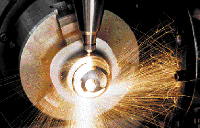Paula M. Powell, Senior Editor
 For perhaps the first time, conventional Nd:YAG lasers face serious competition from other solid-state technologies in a variety of micro- and macroscale cutting and welding applications.
For perhaps the first time, conventional Nd:YAG lasers face serious competition from other solid-state technologies in a variety of micro- and macroscale cutting and welding applications.
On the cutting front, improvements in beam quality and spot sizes with Yb:YAG disk lasers allow sharper inside contour cuts than ever. Diode-pumped fiber laser technology shows promise in microcutting applications such as stainless steel stent implants because of the repeatable, precise control of kerf width and surface quality of the cut edge.
On the welding front, engineers at Rofin Baasel LaserTech in Starnberg, Germany, report that end users benefit from the ability to achieve welding spots between 100 and 800 µm through fiber with disk lasers. They also see the technology expanding quasi-simultaneous welding of larger plastic components, seam welding of aluminum or copper, overlap welding of 100-µm-thick metal foils for fuel cells and a host of remote microwelding applications.
Cost constraints, perhaps, remain the major deterrent to the ability of disk and fiber laser technology to carve out a significant chunk of the industrial market for conventional Nd:YAG technology. The exceptions, at least at present, appear to be in high-volume or problematic applications facing issues such as space constraints or demand for cycle-time reduction or increased precision. Regardless of the advances in beam quality that might be possible, the fact remains that Nd:YAG systems are a proven technology.
Consider Nd:YAG strengths in welding applications, for example. According to Geoff J. Shannon, a laser welding scientist with Unitek Miyachi Corp. in Monrovia, Calif., an Nd:YAG system can offer characteristics from short pulse widths to high peak power that are ideal for spot welding and seam welding, providing penetration with minimal heat input. Pulse-to-pulse stability combined with real-time power feedback ensures that each pulse delivers the same energy and peak power. Systems also offer good control over pulse widths and peak power.
 In addition, Nd:YAG technology continues to improve. Shannon noted that new high-brightness lasers also can be delivered through smaller-diameter fibers, promoting finer spot sizes, albeit not on the same scale as the emerging technologies. However, fiber optic beam delivery was first the realm of Nd:YAG, and companies continue to improve capability for time or energy sharing of output.
In addition, Nd:YAG technology continues to improve. Shannon noted that new high-brightness lasers also can be delivered through smaller-diameter fibers, promoting finer spot sizes, albeit not on the same scale as the emerging technologies. However, fiber optic beam delivery was first the realm of Nd:YAG, and companies continue to improve capability for time or energy sharing of output.
The cost of diode pumping also is an issue within the Nd:YAG market, according to Robert L.A. Schricker, vice president of sales at Lee Laser Inc. in Orlando, Fla., which manufactures both diode- and lamp-pumped solid-state lasers. "Diodes are still a very expensive replacement for an arc lamp, which costs less than $100 and will last 1000, sometimes 2000 hours in our lasers.
"For YAG lasers in the 50- to 100-W range, the cost for the customer to purchase and maintain a lamp-pumped laser is still lower than for a diode-pumped system. Diodes may last 10,000, 20,000 hours or more, but ultimately they, too, must be replaced in most cases -- and that replacement cost is still substantial, sometimes up to half the cost of the laser itself."
Schricker added that there are installations where end users will absolutely need to use diode pumping, such as areas where electrical power is expensive and not as readily available as in the US. "You can basically operate five diode-pumped Nd:YAG lasers for the same electrical power as one lamp-pumped system," he said. "By far, wall-plug efficiency is more of a selling point outside the US, and a large share of our diode-pumped lasers are exported."
Other practical considerations that are slowing deployment of emerging solid-state laser technologies, especially fiber lasers, include simple things like the user interface. According to laser scientist Klaus Kleine with medical device manufacturer Guidant Corp. in Santa Clara, Calif., ease of operation is something that industrial Nd:YAG laser users have come to expect, thanks to features such as graphical user interfaces. They expect the same of any technology attempting to usurp these systems.
The following series of articles will examine these issues with a little more depth.